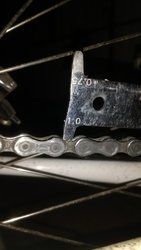iwantanewbike
Über Member
Two years ago I ran experiments testing a few different chain lubes after a regular weekly/200km degreasing and washing interval. Tests proved that no matter the lube, I still reached 0.75% wear in about 1600km. I then tried no degreasing/washing but lubing when squeaky, however that chain also only lasted ~1600km.
I've always been fairly powerful on the pedals but since busting my ankle a year and a half ago and buying a 'gravel bike', my cycling has taken on a much gentler pace. I now generally ride on the off road tracks or shared paths. Accordingly I now get ~2100km out of a chain before hitting the 0.75% mark. So there is all the proof you need that chain wear is linked to the mechanical abuse it gets rather than its cleaning schedule.
My question: am I changing chains still too soon? To get the chain wear tool to drop between the links I need to apply some force on the pedal to "stretch" the chain a bit (it won't go in by itself). If I try the 1.0% side, it doesn't drop in the links at all even if I force the chain. Can I get away with a bit more mileage? Presumably once it starts to allow the 1.0% side to drop slightly then I shouldn't hold off changing it.
I've always been fairly powerful on the pedals but since busting my ankle a year and a half ago and buying a 'gravel bike', my cycling has taken on a much gentler pace. I now generally ride on the off road tracks or shared paths. Accordingly I now get ~2100km out of a chain before hitting the 0.75% mark. So there is all the proof you need that chain wear is linked to the mechanical abuse it gets rather than its cleaning schedule.
My question: am I changing chains still too soon? To get the chain wear tool to drop between the links I need to apply some force on the pedal to "stretch" the chain a bit (it won't go in by itself). If I try the 1.0% side, it doesn't drop in the links at all even if I force the chain. Can I get away with a bit more mileage? Presumably once it starts to allow the 1.0% side to drop slightly then I shouldn't hold off changing it.

